前言
上一篇我们介绍了 Redux 在Flutter 中的基本概念和简单示例,看起来好像也没有那么复杂。但是这些操作都是同步的,点击按钮、发起 Action 调度、然后更新状态、最后更新界面是连贯的。那如果有一个异步请求怎么办,也就是我们可能是点击一个按钮发起的并不是 Action,而是异步网络请求,这个时候又如何通知更新状态?通常来说,在这种场景里我们需要发起三个 Action:
网络加载提示:界面通知用户当前正在请求数据,请等待,通常是一个Loading 提示。
网络请求成功:接收到后端数据,然后通知界面以最新状态的数据刷新界面。
网络请求失败:界面通知用户请求失败,通常是一个错误提示。
这个时候通过按钮点击回调肯定没法完成这样的操作,这个时候就需要利用到 Redux 的中间件了。本篇我们以联系人列表为例,来讲述如何使用中间件完成异步网络请求。
准备工作
首先请更新最新的后端代码:后端代码(基于 Express.js),更新后在目录下运行 node seedContactor.js 产生数据库 Mock 数据,注意图片这里使用的是本机的附件地址,在后端项目的public/upload/image 下面,如果需要展示联系人头像的自己可以找一张图片,然后修改一下seedContactor.js中的 avatar 字段为对应图片文件名。联系人的接口地址为:http://localhost:3900/api/contactor。
更新依赖文件,包括如下插件:
redux: ^5.0.0:最新版的 Redux 插件
flutter_redux: ^0.8.2:Flutter 适配 Redux 的插件
dio: ^4.0.0:网络请求插件
flutter_easyrefresh: ^2.2.1:上拉、下拉刷新组件。
cached_network_image: ^3.1.0:支持缓存的网络图片加载组件。
flutter_easyloading: ^3.0.0:全局的弹窗提醒组件。
shared_preferences: ^2.0.6:本地离线简单键值对存储插件。
拷贝和初始化:从之前的代码中拷贝网络请求的工具类到本工程,完成如 CookieManager 和 EasyLoading 的初始化。当然,你可以直接从这里下载本专栏关于 Redux 篇章的代码:基于 Redux 的状态管理。
完成上述工作后,我们就可以开始撸本篇的代码了。
Redux 三板斧
上篇也说过,Redux 的好处之一就是状态管理的形式是统一的,三个元素 Action、Store 和 Reducer 缺一不可,因此,我们先来梳理联系人列表业务中对应的这三个元素的内容。
首先来定义 Action,列表页面交互上会涉及 2 个Action,刷新和加载更多。但逻辑上还有另外两个动作:获取数据成功和获取数据失败,因此一共有 4 个Action。
刷新:获取第一页的数据,定义为 RefreshAction,在交互时使用下来刷新时调度该 Action。
加载更多:获取下一页的数据,定义为 LoadAction,在交互时使用上拉加载时调用该 Action。
加载成功:网络请求成功,定义为SuccessAction。
加载失败:网络请求异常或错误,定义为 FailedAction。
成功和失败这两个是异步操作,没有用户交互主动 调度的可能,这里留给本篇的主角中间件来处理,稍后再单独介绍。Action 的代码如下,成功和失败因为要携带数据更新状态,因此他们有自己的成员属性:
class RefreshAction {}
class LoadAction {}
class SuccessAction { final List<dynamic> jsonItems; final int currentPage;
SuccessAction(this.jsonItems, this.currentPage);}
class FailedAction { final String errorMessage;
FailedAction(this.errorMessage);}
复制代码
接下来是 Store的状态对象,我们要明确需要哪些数据。首先肯定的是,需要有网络请求成功后的联系人列表数据;其次是当前请求的页码,我们在加载更多的时候需要根据该页面请求下一页数据;之后是 Loading 状态标记和错误信息,Loading 状态标记在某些场合可以用于提示,而错误信息则用于错误提醒。因此,Store 对应的状态数据有:
contactors:联系人列表数据,为 List<dynamic>类型(要与 Dio 接收的数据匹配,只能是该类型)。
isLoading:加载标识,默认是 false,当调度 RefreshAction 或 LoadAction 的时候,标记为 true,当请求成功或失败为 true,标记为 false。
errorMessage:错误信息,允许为空,因此定义为 String?。
currentPage:当前请求页码,默认为 1。
Store 的状态对象类的代码如下:
class ContactorState { final List<dynamic> contactors; final isLoading; final String? errorMessage; final int currentPage;
ContactorState(this.contactors, {this.isLoading = false, this.errorMessage, this.currentPage = 1});
factory ContactorState.initial() => ContactorState(List.unmodifiable([]));}
复制代码
最后是 Reducer 了,Reducer 定义是一个函数,根据旧的状态对象和当前的 Action 来返回新的状态对象。这里的业务逻辑如下:
RefreshAction处理:标记请求状态isLoading为 true,当前页码currentPage为1,其他保留和原先的状态一致。
LoadAction处理:标记请求状态isLoading为 true,当前页码currentPage为旧状态的页面加1,其他保留和原先的状态一致。
FailedAction 处理:更新状态的错误消息,标记请求状态isLoading为 false。
SuccessAction 处理:需要根据最新的请求页码来决定如何更新列表数据。如果当前页码是1,则使用最新的的数据替换掉原有列表;如果当前页面大于1,则将新的数据拼接到旧的数据后面。之后则是更新状态的isLoading为 false,页码为当前 action 的页码,以及清空 errorMessage。
Reducer 的代码如下所示:
ContactorState contactorReducer(ContactorState state, dynamic action) { if (action is RefreshAction) { ContactorState contactorState = ContactorState(state.contactors, isLoading: true, errorMessage: null, currentPage: 1); return contactorState; } if (action is LoadAction) { ContactorState contactorState = ContactorState(state.contactors, isLoading: true, errorMessage: null, currentPage: state.currentPage + 1); return contactorState; }
if (action is SuccessAction) { int currentPage = action.currentPage; List<dynamic> contactors = state.contactors; if (currentPage > 1) { contactors += action.jsonItems; } else { contactors = action.jsonItems; } ContactorState contactorState = ContactorState(contactors, isLoading: false, errorMessage: null, currentPage: currentPage); return contactorState; }
if (action is FailedAction) { ContactorState contactorState = ContactorState( state.contactors, isLoading: false, errorMessage: action.errorMessage, ); return contactorState; }
return state;}
复制代码
中间件
所谓的中间件,其实就和我们之前的 Dio 的拦截器类似,也就是在调度 Action 前会先执行中间件方法,处理完之后再交给下一个中间件处理。Redux 的拦截器定义在 Store 构造方法中,形式为:
void (Store<T> store, action, NextDispatcher next)
复制代码
在这里,我们定义的中间件方法名为:fetchContactorMiddleware,需要在构建 Store 对象时加入到 middleware 参数中。middleware本身是一个数组,因此我们可以添加多种中间件,以便进行不同的处理。
final Store<ContactorState> store = Store( contactorReducer, initialState: ContactorState.initial(), middleware: [ fetchContactorMiddleware, ],);
复制代码
在中间件中我们可以获取到当前的 Action和状态,因此可以根据 Action 做不同的业务。在这里我们只需要处理刷新和加载更多:
刷新时,将页码置为 1,请求数据,请求成功后发起 SuccessAction 调度,通知状态更新。
加载更多时,将页码加 1 后再请求数据,请求成功后发起 SuccessAction 调度,通知状态更新。
请求失败都发起 FailedAction 调度,通知状态请求失败。
处理完之后,记得调用 next 方法,将当前action传递过去,一般完成正常的调度过程。中间件的代码如下:
void fetchContactorMiddleware( Store<ContactorState> store, action, NextDispatcher next) { const int pageSize = 10; if (action is RefreshAction) { // 刷新取第一页数据 ContactorService.list(1, pageSize).then((response) { if (response != null && response.statusCode == 200) { store.dispatch(SuccessAction(response.data, 1)); } else { store.dispatch(FailedAction('请求失败')); } }).catchError((error, trace) { store.dispatch(FailedAction(error.toString())); }); }
if (action is LoadAction) { // 加载更多时页码+1 int currentPage = store.state.currentPage + 1; ContactorService.list(currentPage, pageSize).then((response) { if (response != null && response.statusCode == 200) { store.dispatch(SuccessAction(response.data, currentPage)); } else { store.dispatch(FailedAction('请求失败')); } }).catchError((error, trace) { store.dispatch(FailedAction(error.toString())); }); }
next(action);}
复制代码
页面代码
页面代码和上一篇的结构类似,但是本篇构建了一个 ViewModel 类,使用了 StoreConnector 的 converter 方法将状态的中的列表数据转换为页面展示所需要的对象。
class _ViewModel { final List<_ContactorViewModel> contactors;
_ViewModel(this.contactors);
factory _ViewModel.create(Store<ContactorState> store) { List<_ContactorViewModel> items = store.state.contactors .map((dynamic item) => _ContactorViewModel.fromJson(item)) .toList();
return _ViewModel(items); }}
class _ContactorViewModel { final String followedUserId; final String nickname; final String avatar; final String description;
_ContactorViewModel({ required this.followedUserId, required this.nickname, required this.avatar, required this.description, });
static _ContactorViewModel fromJson(Map<String, dynamic> json) { return _ContactorViewModel( followedUserId: json['followedUserId'], nickname: json['nickname'], avatar: UploadService.uploadBaseUrl + 'image/' + json['avatar'], description: json['description']); }}
复制代码
页面的build方法如下,可以看到页面中没有体现中间件部分的代码,而是在 dispatch 过程中自动完成了。
@overrideWidget build(BuildContext context) { return StoreProvider<ContactorState>( store: store, child: Scaffold( //省略 appBar body: StoreConnector<ContactorState, _ViewModel>( converter: (Store<ContactorState> store) => _ViewModel.create(store), builder: (BuildContext context, _ViewModel viewModel) { return EasyRefresh( child: ListView.builder( itemBuilder: (context, index) { return ListTile( leading: _getRoundImage(viewModel.contactors[index].avatar, 50), title: Text(viewModel.contactors[index].nickname), subtitle: Text( viewModel.contactors[index].description, style: TextStyle(fontSize: 14.0, color: Colors.grey), ), ); }, itemCount: viewModel.contactors.length, ), onRefresh: () async { store.dispatch(RefreshAction()); }, onLoad: () async { store.dispatch(LoadAction()); }, firstRefresh: true, ); }, ), // 省略其他代码 ), );
复制代码
这里需要注意,EasyRefresh 组件要放置在 StoreConnector 的下一级,否则会因为在刷新的时候找不到下级ScrollView,报null错误。
运行结果
运行结果如下图所示,整个运行和之前我们使用Provider没有太大区别,但是从封装性来看,使用 Redux 的封装性会更好,比如网络请求部分的业务放在了中间件,对于组件层面来说只需要关心要发起什么动作,而不需要关心具体动作后要怎么处理。代码已提交至:Redux 相关代码。
总结
先来梳理一下 Redux 加了中间件的整个流程,如下图所示。
加入了中间件后,在异步完成后可以触发异步操作相关的 Action,以便将异步结果通过Reducer处理后更新状态。引入中间件后,可以使得异步操作与界面交互分离,进一步降低的耦合性和提高了代码的可维护性。
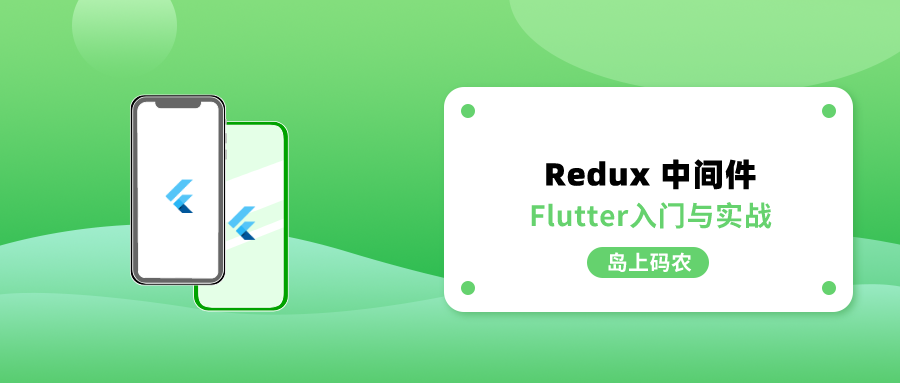
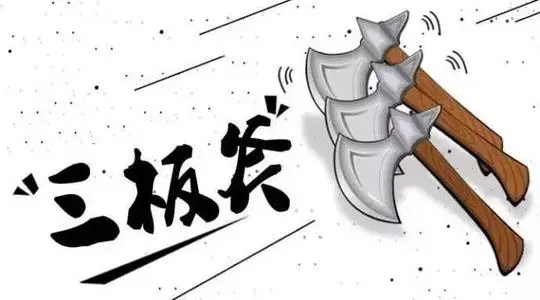
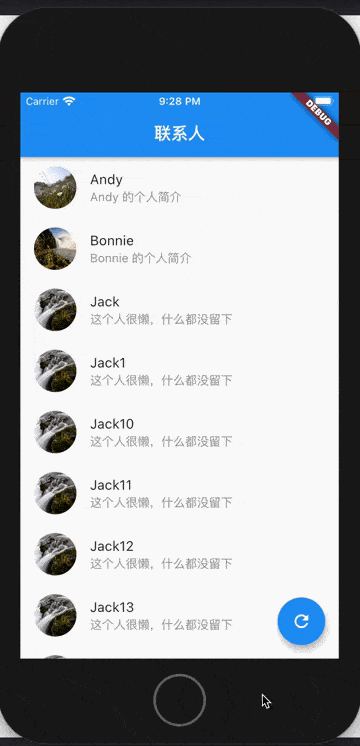
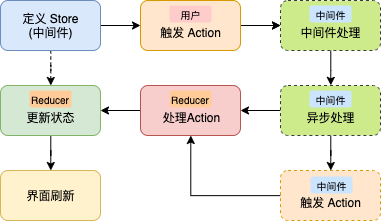
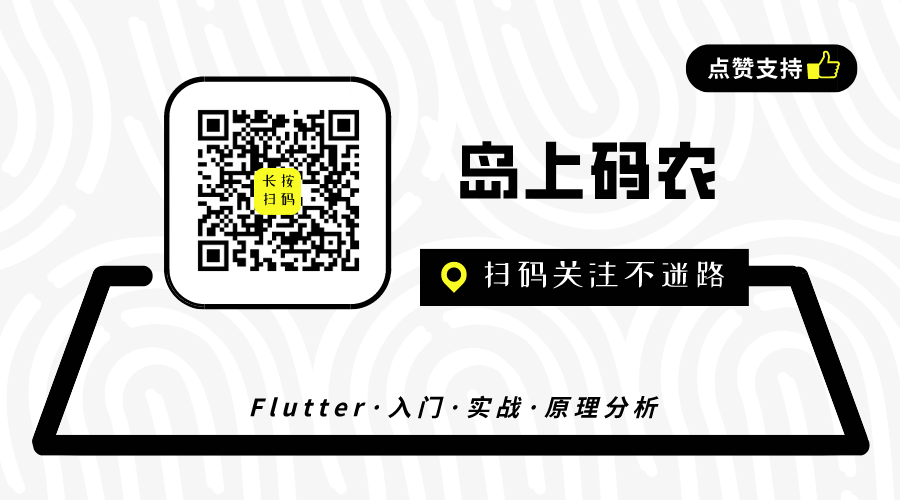











评论